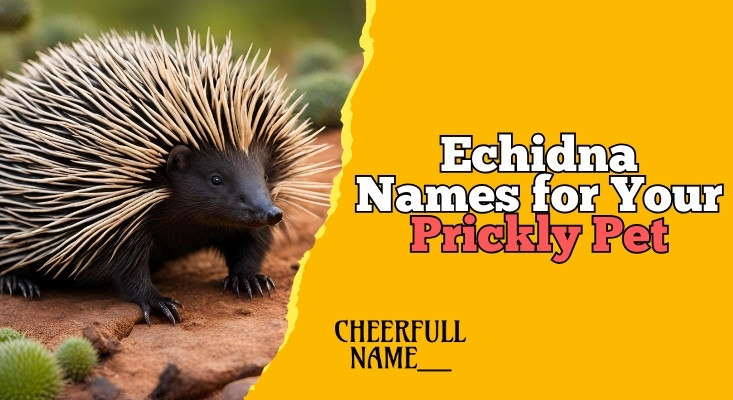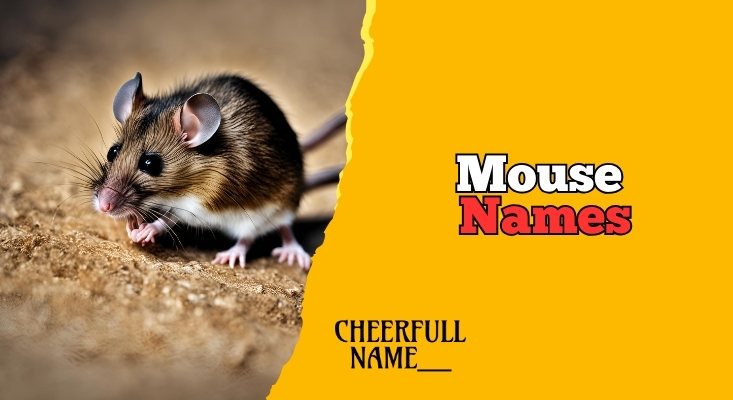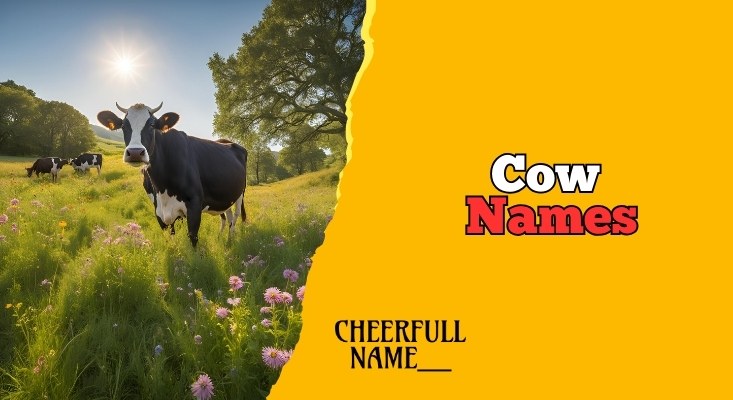Embracing the Quirky Charm: A World of Wonderful Echidna Names
The enchanting echidna, with its distinctive bristly coat and endearing demeanor, is a creature like no other. As you welcome one of these spiky sweethearts into your life, finding the perfect name becomes a thrilling adventure.
Our collection of echidna names celebrates their unique spirit, blending playful, cute, and clever ideas to suit both males and females.
Inspired by their remarkable appearance and abilities, our names pay tribute to these fascinating creatures. From nods to pop culture icons to whimsical wordplay, each suggestion is carefully crafted to capture the essence of your new prickly pal.
Join us on this fun-filled journey as we explore a diverse array of echidna names, carefully curated to help you find the ideal fit for your beloved companion.
Whether you’re drawn to silly, sweet, or sophisticated options, our list has something for everyone. Get ready to fall in love with the perfect name for your echidna!
Contents
What Is Echidna Scientific Name?
Formation of the Name
A Blend of Greek and Latin Roots
The scientific name for the echidna, Tachyglossus aculeatus, is a masterful combination of Greek and Latin words that perfectly capture the essence of this unique creature.
Tachyglossus: A Swift Tongue
The genus name, Tachyglossus, is derived from the Greek words “tachys,” meaning swift, and “glossa,” meaning tongue. This refers to the echidna’s remarkable ability to flick its tongue in and out with incredible speed, catching ants and termites with lightning-fast precision.
Aculeatus: A Spiny Coat
The species name, aculeatus, comes from the Latin word for spiny or thorny, aptly describing the echidna’s distinctive coat of sharp quills. This unique feature serves as a formidable defense mechanism, protecting the echidna from predators.
A Name that Fits
Together, the name Tachyglossus aculeatus paints a vivid picture of an animal that is both swift and spiny, highlighting the echidna’s remarkable adaptations that have fascinated scientists and animal enthusiasts alike.
Echidna Species Name
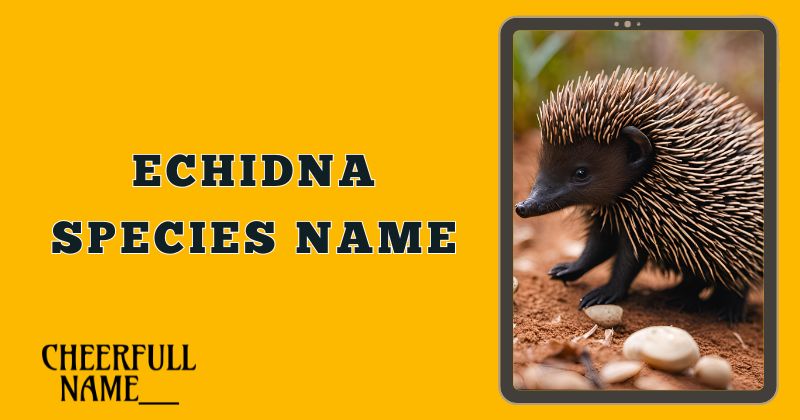
Meet the Four Fascinating Species of Echidnas
Echidnas, also known as spiny anteaters, are part of the family Tachyglossidae. Let’s explore the unique characteristics of each of the four recognized species:
1. Short-Beaked Echidna (Tachyglossus aculeatus)
Adaptable and Widespread: Found in Australia, Tasmania, and southern New Guinea, this species thrives in various environments, from forests to deserts. Its short, stout snout and dense spines make it a distinctive creature. With its long, sticky tongue, it feasts on ants and termites.
2. Sir David’s Long-Beaked Echidna (Zaglossus attenboroughi)
A Critically Endangered Giant: Native to the Cyclops Mountains in Indonesia, this species boasts a long beak and larger body. Named after Sir David Attenborough, it’s considered critically endangered due to habitat loss and hunting. Earthworms and invertebrates are its primary food sources.
3. Eastern Long-Beaked Echidna (Zaglossus bartoni)
Highland Digger: Inhabiting Papua New Guinea’s highland forests, this echidna has a longer snout and fewer spines. Its larger size and powerful claws make it a skilled digger, uncovering earthworms and insects in the soil and leaf litter.
4. Western Long-Beaked Echidna (Zaglossus bruijni)
Rainforest Specialist: Found in New Guinea’s rainforests, this echidna has an exceptionally long snout and cylindrical body. Critically endangered, it faces threats from habitat destruction and hunting. Earthworms are its main food source, probed from the soil with its elongated snout.
Echidnas are one-of-a-kind mammals, laying eggs and possessing unique reproductive anatomy. Conservation efforts are vital for their survival, especially for the critically endangered long-beaked species.
|| Echidna Interesting Name
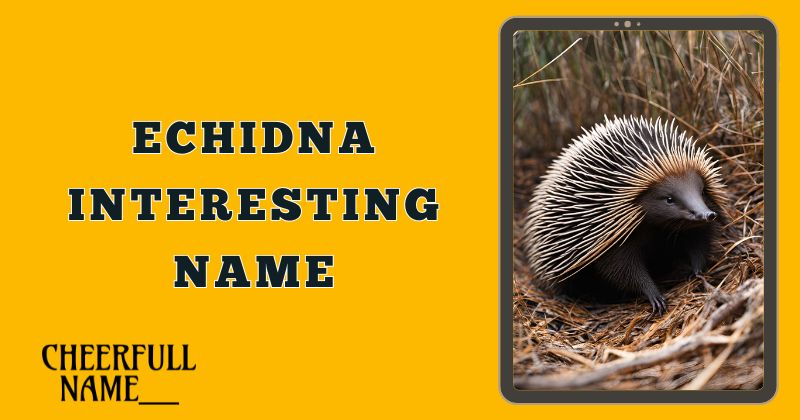
The echidna’s scientific name, Tachyglossus aculeatus, is a fascinating combination of Greek and Latin words. “Tachyglossus” comes from the Greek words “tachys,” meaning swift, and “glossa,” meaning tongue, referring to the echidna’s rapid tongue movements.
“Aculeatus” is Latin for spiny or thorny, describing the echidna’s distinctive coat of sharp quills. This unique name reflects the echidna’s remarkable characteristics.
|| Echidna Names Male

Male echidnas deserve names that reflect their rugged, spiny exterior and their charming, gentle nature. Consider names like Spike, Quill, or Thistle for a male echidna. These names capture their prickly yet endearing personality. You can also opt for names like Max, Milo, or Archie for a more playful, affectionate vibe.
|| Echidna Common Name
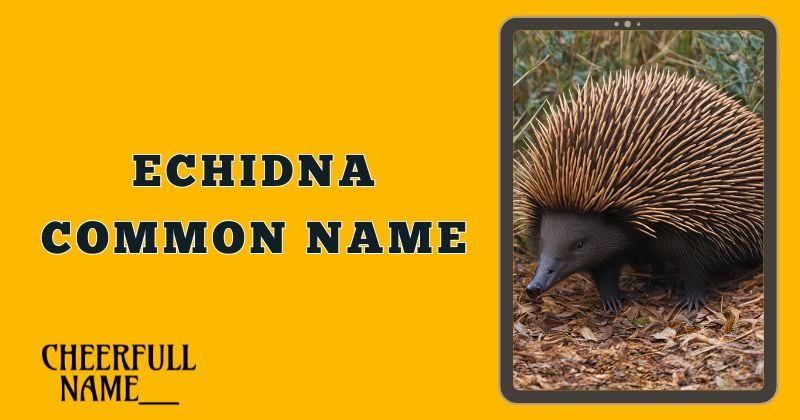
The echidna’s common name, “spiny anteater,” perfectly describes its distinctive appearance and feeding habits. This name is widely used due to the echidna’s striking spines and its love for snacking on ants and termites. The common name is simple, yet informative, making it easy to identify and remember this unique creature.
|| Echidna Group Name

A group of echidnas is called a “parade” of echidnas! This charming collective noun suits these social, burrowing creatures. When echidnas gather, they often form a line, following each other’s scent trails. The term “parade” captures their unique social behavior and adorable, waddling gait.
Echidna Name For Baby

For a baby echidna, consider names that are cute, playful, and reflective of their youth. Names like Echi, Spikelet, or Quilliam are perfect for a young echidna. These names are endearing, easy to pronounce, and suit the echidna’s innocent, curious nature. You can also opt for names like Luna, Lola, or Gracie for a more affectionate, gentle vibe.
|| Echidna Name For Baby
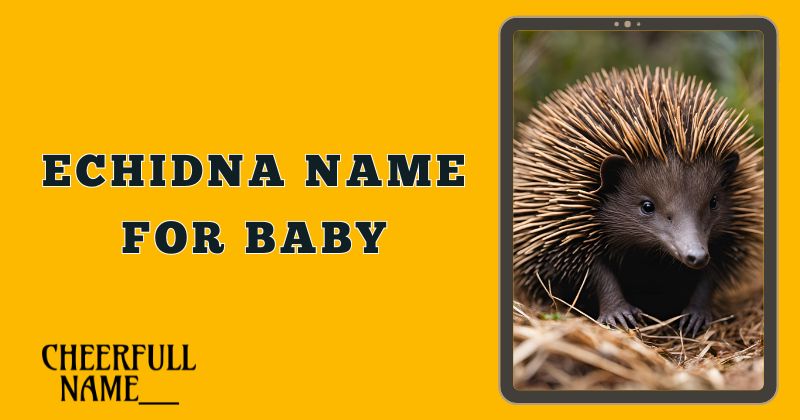
Echidnas have many other names that reflect their unique characteristics, habits, or appearances. Some of these names include:
How to Craft Perfect Echidna Names?
Crafting the perfect name for an echidna requires a thoughtful and creative approach. Start by researching the unique characteristics and traits of these fascinating creatures, such as their spiky quills, long snouts, and burrowing habits.
Next, choose a naming theme that resonates with these features, like spiky or quill-inspired names, burrowing or underground-themed names, or Australian or indigenous-inspired names.
Brainstorm a list of potential names that fit your chosen theme, considering names that sound cute and endearing for a baby echidna, reflect their unique features or habits, or are easy to pronounce and remember.
When selecting a name, think about the length and structure that suits your taste. You might prefer a short and snappy name like Spike or Quill, a medium-length name like Echidna or Burrower, or a longer, more descriptive name like Spinytail or Tongueflick.
Ensure the name flows well and is easy to pronounce. To guarantee uniqueness, research existing echidna names and modify or combine them to create a distinctive name.
. By following these steps, you’ll find the perfect name for your echidna that reflects their one-of-a-kind spirit.
Final Words
Naming your echidna companion can be a delightful adventure! Their charming quirks and unique characteristics offer a wealth of inspiration for finding the ideal moniker. The right name should celebrate their distinct traits and personality, making it a true reflection of their individuality.
We’ve curated a list of carefully selected names that cater to various personalities, ensuring there’s a fitting choice for every echidna. From playful and whimsical to descriptive and clever, these names are designed to capture the essence of your spiky friend.
Whether you’re looking for something classic and simple or bold and adventurous, we’ve got you covered. With a little creativity, you’ll find the perfect name to suit your echidna’s one-of-a-kind spirit.
FAQs !!
Q1. Are echidnas dangerous?
No, echidnas are not typically considered dangerous to humans. They are shy and solitary animals that prefer to avoid confrontations. However, they do have sharp quills that can cause injury if they feel threatened or cornered.
Q2. Do echidnas lay eggs?
Yes, echidnas are one of the few mammals that lay eggs instead of giving birth to live young. This characteristic is known as oviparity.
Q3. Do echidnas have pouches?
Yes, female echidnas have a pouch on their belly where they carry their eggs and later, their young. The pouch provides a safe and nourishing environment for the developing echidna.
Q4. How to check echidna pouch?
To check an echidna’s pouch, gently lift the echidna and inspect the underside of their body. The pouch is located on the belly, near the base of the tail. If the echidna is carrying eggs or young, you may feel a slight bulge or see a small opening.
Q5. What does the echidna look like?
Echidnas have a distinctive appearance, with a round, furry body covered in sharp, pointed quills. They have a long, pointed snout, small eyes, and powerful claws for digging. Adult echidnas typically range from 30-40 cm in length and weigh between 2-6 kg.
Q6. What do echidnas eat?
Echidnas are insectivores and feed on ants, termites, and other small invertebrates. They use their long, sticky tongues to catch their prey.
Q7. Where do echidnas live?
Echidnas are native to Australia and New Guinea, and can be found in a variety of habitats, including forests, grasslands, and deserts. They are skilled diggers and often live in burrows or under rocks and logs.

